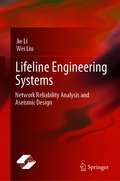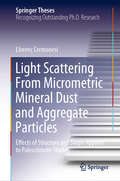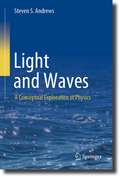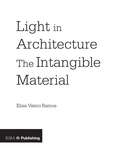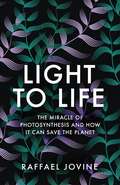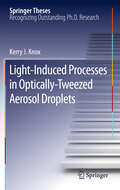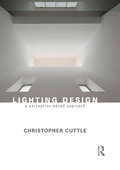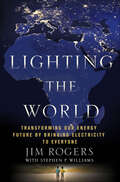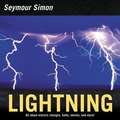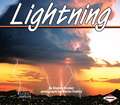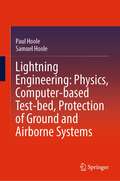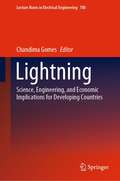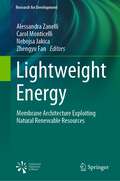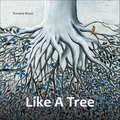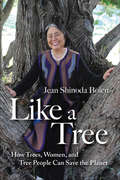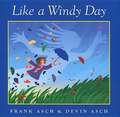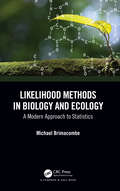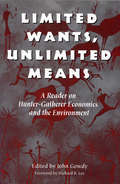- Table View
- List View
Lifeline Engineering Systems: Network Reliability Analysis and Aseismic Design
by Wei Liu Jie LiThis book, for the first time, introduces comprehensively all main topics of lifeline earthquake engineering, including the structure analysis, network evaluation, and network design. The distinctive features involved in this book are the construction of theories and methods for stochastic analysis of structures based the physical idea, probability analytical algorithms for network evaluation by employing Boolean Algebra, functional evaluation of water distribution networks using hydraulic analysis, and network design methods by employing genetic, simulated annealing, and hybrid algorithms.
Lifelines: The Case For River Conservation
by Tim Palmer"In Lifelines, Tim Palmer addresses the fate of our waterways. While proposals for gigantic federal dams are no longer common, and some of the worst pollution has been brought under control, myriad other concerns have appeared -- many of them more subtle and complex than the threats of the past.Palmer examines the alarming condition of rivers in today's world, reports on the success in restoring some of our most polluted streams and in stopping destructive dams, and builds the case for what must be done to avoid the collapse of riparian ecosystems and to reclaim qualities we cannot do without. He documents the needs for a new level of awareness and suggests ways to avert the plunder of our remaining river legacy.Lifelines offers a fresh perspective on: the values of natural rivers current threats to streams and possibilities for reform the continuing challenge of hydropower development water quality, instream flows, and riparian habitat ecosystem management and watershed protection the need for vision, hope, and action
Lifelong Learning for Green Skills and Sustainable Development: Southern European Perspectives
by Nikša Alfirević Jurica Pavičić Tihomir Žiljak Philippe RistordThis edited book analyses the implementation of green transformation policies and the UN Sustainable Development Goals across the European Union, in the context of lifelong learning and educational practices. The contributions examine how green skills became mainstreamed in member states’ education policies, as well as the social, economic and political circumstances contributing to this process. A focus on lifelong learning (from an early age to adulthood) is maintained throughout the volume, and the book will appeal to researchers, students, policy- and decision-makers in education, environmental and social studies.
Lifetime Environmental Impact of Buildings
by Marc Méquignon Hassan Ait HaddouThis work discusses the impact of the life of buildings on sustainable development methods The study of the lifespan of the building is used to assess and manage the environmental impacts associated with all the stages of a product's life, from raw material extraction through to repair, maintenance and 'end of life' scenarios. While several papers have discussed the greenhouse gas emissions of buildings, less research has been done on how these are affected by the lifespan of the building. This book serves to highlight the pertinence of this factor and contributes to providing new ideas on efficiency within the life cycle assessment of a structure.
Light Scattering From Micrometric Mineral Dust and Aggregate Particles: Effects of Structure and Shape Applied to Paleoclimate Studies (Springer Theses)
by Llorenç CremonesiLight scattering from particles in the nanometric and micrometric size range is relevant in several research fields, such as aerosol science and nanotechnology. In many applications, the description of the optical properties of non-spherical, inhomogeneous particles is still inadequate or requires demanding numerical calculations. Lorenz–Mie scattering and effective medium approximations represent currently the main theoretical tools to model such particles, but their effectiveness has been recently called into question.This work examines how the morphology of a particle affects its scattering parameters from an experimental standpoint, supporting findings with extensive simulations. The dust content of Antarctic, Greenlandic, and Alpine ice cores is analysed with a particle-by-particle approach. Moreover, a study on colloidal aggregates shows that correlations among the fields radiated by primary particles are responsible for the poor agreement of effective medium approximations with experimental results. On the theoretical side, an interpretation in terms of the structure factor is given, which satisfactorily describes the data. The insights of this thesis are relevant for quantifying the contribution of mineral dust to the radiative energy balance of the Earth.
Light and Waves: A Conceptual Exploration of Physics
by Steven S. AndrewsThis book explores light and other types of waves, using this as a window into other aspects of physics. It emphasizes a conceptual understanding, using examples chosen from everyday life and the natural environment. For example, it explains how hummingbird feathers create shimmering colors, how musical instruments produce sound, and how atoms stick together to form molecules. It provides a unique perspective on physics by emphasizing commonalities among different types of waves, including string waves, water waves, sound waves, light waves, the matter waves of quantum mechanics, and the gravitational waves of general relativity. This book is targeted toward college non-science majors, advanced high school students, and adults who are curious about our physical world. It assumes familiarity with algebra but no further mathematics and is classroom-ready with many worked examples, exercises, exploratory puzzles, and appendices to support students from a variety of backgrounds.
Light in Architecture: The Intangible Material
by Elisa Valero RamosLight in Architecture explores the role and use of light in and around buildings from the time that Stonehenge was built through to the present day, illustrating how a greater understanding of this intangible and free material will lead us to better architecture and, ultimately, improve our quality of life. Translated and carefully updated from the best-selling Spanish book, La Materia Intangible, this full colour edition explains why light is so fundamental to human perception, how its nature and use are influenced by time and place, and how it has come to be used as a tool for abstract architectural design. Drawing on centuries of thinking and over 40 real-life, international exemplars, the book explores the different ways that light can be harnessed and manipulated to achieve particular objectives, emotions or experiences, as well as how the technologies and techniques for doing so have developed over time.
Light to Life: The miracle of photosynthesis and how it can save the planet
by Raffael Jovine"Read this book and you will learn how photosynthesis was discovered, how it works, and how we can produce more food to feed the world." - PAUL NURSE, Nobel Prize winner and author of What is Life?In Light to Life, biologist Raffael Jovine takes us on a journey of discovery into the intricate, beautiful and often surprising processes that convert energy from the sun into life and how all-important these are to our survival.Despite the unprecedented challenges the Earth faces from global warming, habitat loss, air pollution and population growth; Jovine shows us that there is hope to be found. Photosynthesis is the very source of life: it has the power not just to produce food, but to reshape continents, drive biogeochemical cycles, stabilise the climate and regulate weather.In this exciting, revelatory book, Jovine unveils a blueprint for the future: greening the desert, bringing the ocean on land, planting mangrove forests and oyster banks, growing algae for animal feed, human food and soil carbon... He demonstrates how by harnessing photosynthesis we can regenerate the planet and revise the way we human beings interact with it.This book will help you to see the world in a different way, in all its wonderful detail - through the photosynthetic pigments in your eyes.
Light-Induced Processes in Optically-Tweezed Aerosol Droplets
by Kerry J. KnoxAerosols play a critical role in a broad range of scientific disciplines, such as atmospheric chemistry and physics, combustion science, drug delivery and human health. This thesis explores the fundamentals of a new technique for capturing single or multiple particles using light, and for characterising these particles by Raman or fluorescence spectroscopy. The outcome of this research represents a significant development in optical manipulation techniques, specifically in optical tweezing. These findings can be applied to studies of the mass accommodation of gas-phase water molecules adsorbing onto a water surface. Not only is this a fundamental process of interest to physical chemists, but it is important for understanding the role of aerosol particles in the atmosphere, including their ability to become cloud droplets. This new strategy for investigating aerosol dynamics is fundamental in helping us understand the indirect effect of aerosols on the climate.
Lighting Design: A Perception-Based Approach
by Christopher CuttleBy reading this book, you will develop the skills to perceive a space and its contents in light, and be able to devise a layout of luminaires that will provide that lit appearance. Written by renowned lighting expert Christopher (Kit) Cuttle, the book: explains the difference between vision and perception, which is the distinction between providing lighting to make things visible, and providing it to influence the appearance of everything that is visible; demonstrates how lighting patterns generated by three-dimensional objects interacting with directional lighting are strongly influential upon how the visual perception process enables us to recognize object attributes, such as lightness, colourfulness, texture and gloss; reveals how a designer who understands the role of these lighting patterns in the perceptual process may employ them either to reveal, or to subdue, or to enhance the appearance of selected object attributes by creating appropriate spatial distributions of light; carefully explains calculational techniques and provides easy-to-use spreadsheets, so that layouts of lamps and luminaires are derived that can be relied upon to achieve the required illumination distributions. Practical lighting design involves devising three-dimensional light fields that create luminous hierarchies related to the visual significance of each element within a scene. By providing you with everything you need to develop a design concept - from the understanding of how lighting influences human perceptions of surroundings, through to engineering efficient and effective lighting solutions – Kit Cuttle instills in his readers a new-found confidence in lighting design.
Lighting the World: Transforming Our Energy Future by Bringing Electricity to Everyone
by Jim Rogers Stephen P. WilliamsA former power company executive “makes his provocative case for powering up the Third World” (Discover).Without electricity, everything is harder. Imagine no cell phones, refrigerators, kitchen lights, or radios. Imagine having to finish all the day’s tasks—cooking, working, cleaning—before the sun goes down. Your children couldn’t do homework; you couldn’t read. It seems unthinkable today, yet this is how a staggering number of people on Earth still live. But Jim Rogers believes that can soon change—transforming not only people’s daily lives, but also their hopes for the future.In Lighting the World, Rogers describes how an international coalition can come together to secure financing, spearhead the newest and cleanest technologies, and work with the governments, entrepreneurs, and NGOs already on the ground to ensure that everyone has access to a steady and reliable supply of power. In today’s competitive world, Rogers believes, that shouldn’t be an accidental privilege, but a fundamental human right.Praise for Lighting the World“A passionate, but not ideological, argument that offers a practical approach to solving real problems.” —Kirkus Reviews“An enthusiastic account and a great starting point for readers curious about sustainable, worldwide electricity.” —Library Journal“In Lighting the World, Jim Rogers treats us to two books in one: a gripping journey around the dramatic world of energy for the poor combined with a fascinating account of what it takes to run and innovate a major U.S. utility.” —Dan Kammen, Professor of Energy, Energy and Resources Group & Goldman School of Public Policy, University of California
Lightning
by Seymour SimonExceptional nonfiction for children from two of the most trusted names in science education: Seymour Simon and the Smithsonian Institution.
Lightning
by Stephen KramerCovers a variety of facts on lightning, including how it is formed, the different types of lightning, what thunder is and its relationship to lightning, safety measures, etc.
Lightning Discharges: Formation, Terminologies, Measurements and Theory (SpringerBriefs in Applied Sciences and Technology)
by Pitri Bhakta Adhikari Aashutosh AdhikariThis book highlights the basic information about lightning. It is an unpredictable disaster, and it is an extremely complex electrical discharge phenomenon. A complete theory of lightning does not exist till now. This book elaborates on the basic formation of lightning, terminologies related to lightning, and the preliminary lightning theory. There are different types of lightning, such as cloud flashes, ground flashes (both positive and negative), and air discharges. This book explains some unusual events related to lightning and inspects innovation. This book also describes the measurement of electric and magnetic fields generated by lightning, which are the basic parameters for lightning fundamentals.
Lightning Engineering: Physics, Computer-based Test-bed, Protection of Ground and Airborne Systems
by Paul Hoole Samuel HooleThis book gives a contemporary and comprehensive overview of the physics of lightning and protection systems, based on nearly 40 years of research, teaching, and consultancy work in this area. The book begins with an overview of the climatology of lightning and electric storms, as well as giving insight into lightning discharge from the preliminary discharges or processes such as corona, stepped leader, and subsequent return strokes, including the important submicrosecond threats and continuous current. The subsequent chapters present measures of lightning threat analysis to aircraft and electric power systems, protection measures to be used in high-voltage to low-voltage computer and communication systems, as well as to commercial and domestic buildings. The book discusses challenges posed by the submicrosecond lighting current changes and climate change to present and future high-voltage apparatus and structures (including carbon composite aircraft and new buildings) exposed to lightning strikes. Including worked examples, illustrations, and detailed analysis, Lightening Engineering will be of interest to electrical engineers, as well as researchers and graduate students.
Lightning Strikes
by Charlene BrussoHow is lightning created? And what is thunder? What kind of weather creates the most lightning? This science story shows how lightning is like the spark from static electricity, but much bigger.
Lightning: Science, Engineering, and Economic Implications for Developing Countries (Lecture Notes in Electrical Engineering #780)
by Chandima GomesThis book highlights the essential theoretical and practical aspects of lightning, lightning protection, safety and education. Additionally, several auxiliary topics that are required to understand the core themes are also included. The main objective of the contents is to enlighten the scientists, researchers, engineers and social activists (including policy makers) in developing countries regarding the key information related to lightning and thunderstorms. A majority of developing countries are in tropics where the lightning characteristics are somewhat different from those in temperate regions. The housing structures and power/communication networks, and human behavioural patterns(that depends on socio-economic parameters) in these countries are also different from those in the developed world. As the existing books on similar themes address only those scenarios in developed countries, this book serves a vast spectrum of readership in developing world who seek knowledge in the principles of lightning and a practical guidance on lightning protection and safety education.
Lightweight Energy: Membrane Architecture Exploiting Natural Renewable Resources (Research for Development)
by Alessandra Zanelli Carol Monticelli Nebojsa Jakica Zhengyu FanThis book explores membrane materials as a means of translating natural and renewable resources into a more flexible, dynamic, and reactive architectural skin. It represents the first time that energy-saving design has been addressed systematically in relation to lightweight building systems and tensile membranes. Understanding of the energetic behavior of membranes and foils used as a building envelope is a fundamental theme, as it is the integration of flexible photovoltaics in membranes, as well as the exploitation of water and wind resources. A theoretical, methodological framework for consciously designing the membrane life cycle is presented. The authors cross-cut and combine exploration of climate-based design methodology and life cycle thinking strategies. Both active and passive systems are investigated, referring to alternative productive resources like sun, wind, and water. Case studies are brought forward in the book’s second half, highlighting energy lightness for an increasingly dematerialized architecture and addressing inherent issues. Four main research and development paths are presented, the first two focusing on advancements in façade materials and Photovoltaic systems applicable to membrane architecture, the third referring to fog and dew harvesting and the fourth dealing with the future frontier of flexible transparency and designs for well-being through a passive solar system.
Like a Tree
by Rossana BossùAn engaging internationally award-winning title that captures the beauty of life and symmetries in nature in a mixture of poetry and science for young readers. Poetic language and science come together for a truly remarkable look at what makes us all alive. Beautiful illustrations feature simple verbs, leading into lyrical text that shows the life cycles of various living things in nature, comparing the actions of human life to a tree. From the trees to the birds to a single tiny snowflake, we all live together, dance together, and breathe together to create a symphony of life. Clear facts and vivid imagery give the reader enough to use their imagination to look at nature and look at themselves with wonder and to discover how everything is connected.
Like a Tree: How Trees, Women, and Tree People Can Save the Planet
by Jean Shinoda BolenThe internationally known author and speaker provides an insightful look into the fusion of ecological issues and global gender politics.This book on the importance of trees grew out of Bolen’s experience mourning the loss of a Monterey pine that was cut down in her neighborhood. That, combined with her practice of walking among tall trees, led to her deep connection with trees and an understanding of their many complexities. She expertly explores the dynamics of ecological activism, spiritual activism, and sacred feminism. And, she invites us to join the movement to save trees.While there is still much work to be done to address environmental problems, there are many stories of individuals and organizations rising up to make a change and help save our planet. The words and stories that Bolen weaves throughout this book are both inspirational and down-to-earth, calling us to realize what is happening to not only our trees, but our people.In Like a Tree learn more about: The dynamic nature of trees — from their anatomy to their role as an archetypal symbol Pressing social issues such as deforestation, global warming, and overpopulation What it means to be a “tree person”“You will never again see [a tree] without knowing it has a novel inside, it’s supporting your life, and it’s more spiritual than any church, temple or mosque. Like a Tree is the rare book that not only informs, but offers a larger consciousness of life itself.” —Gloria Steinem
Like a Windy Day
by Frank AschThe wind is powerful and stormy, mischievous and unpredictable. In this magical story, a young girl goes soaring, tumbling, and twirling on her own exciting windy-day adventure.
Likelihood Methods in Biology and Ecology: A Modern Approach to Statistics
by Michael BrimacombeThis book emphasizes the importance of the likelihood function in statistical theory and applications and discusses it in the context of biology and ecology. Bayesian and frequentist methods both use the likelihood function and provide differing but related insights. This is examined here both through review of basic methodology and also the integr
Liminality, Transgression and Space Across the World: Being, Living and Becoming(s) Against, Across and with Borders and Boundaries
by Basak Tanulku Simone PekelsmaThis book analyses various forms of liminality and transgression in different geographies and demonstrates how and why various physical and symbolic boundaries create liminality and transgression.Its focus is on comprehending the ways in which these borders and boundaries generate liminality and transgression rather than viewing them solely as issues. It provides case studies from the past and present, allowing readers to connect subjects, periods, and geographies. It consists of theoretical and empirical chapters that demonstrate how borders and liminality are interconnected. The book also benefits from the power of several visual essays by artists to complete the theoretical and empirical chapters which demonstrate different forms of liminality without need of much words.The book will be of interest to researchers and students working in the fields of urban and rural studies, urban sociology, cities and communities, urban and regional planning, urban anthropology, political science, migration studies, human geography, cultural geography, urban anthropology, and visual arts.
Limit Analysis Theory of the Soil Mass and Its Application
by Chuanzhi HuangThis book establishes the equations of limit analysis and provides a complete theoretical basis for foundation capacity, slope stability, and earth pressure. It is divided into three parts, the first of which discusses the failure mode and fundamental equation of soil mass. The second part addresses the solution methods for limit analysis, including the characteristic line method, stress field method, limit equilibrium method, virtual work equation-based generalized limit equilibrium method and generalized limit equilibrium method for the surface failure mode. Lastly, the third part examines the application of the limit analysis theory to soil mass.
Limited Wants, Unlimited Means: A Reader On Hunter-Gatherer Economics And The Environment
by John GowdyFor roughly 99% of their existence on earth, Homo sapiens lived in small bands of semi-nomadic hunter-gatherers, finding everything they needed to survive and thrive in the biological richness that surrounded them. Most if not all of the problems that threaten our own technologically advanced society -- from depletion of natural capital to the ever-present possibility of global annihilation -- would be inconceivable to these traditional, immediate-return societies. In fact, hunter-gatherer societies appear to have solved problems of production, distribution, and social and environmental sustainability that our own culture seems incapable of addressing.Limited Wants, Unlimited Means examines the hunter-gatherer society and lifestyle from a variety of perspectives. It provides a brief introduction to the rich anthropological and sociological literature on non-agricultural societies, bringing together in one volume seminal writings on the few remaining hunter-gatherer cultures including, the !Kung, the Hadza, and the Aborigines. It examines the economics of traditional societies, and concludes with a multifaceted investigation of how such societies function and what they can teach us in our own quest for environmental sustainability and social equality.Limited Wants, Unlimited Means is an important work for students of cultural anthropology, economic anthropology, environmental studies, and sustainable development, as well as for professionals, researchers, and anyone interested in prehistoric societies, environmental sustainability, or social justice.
